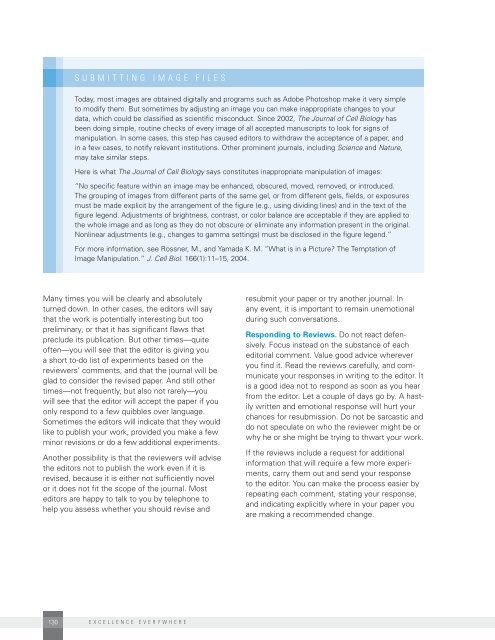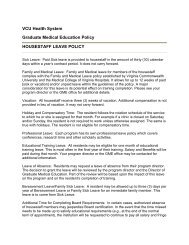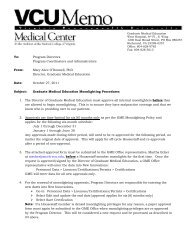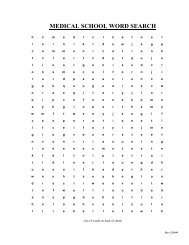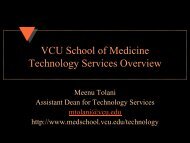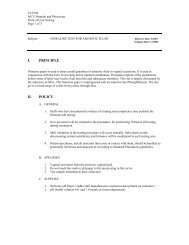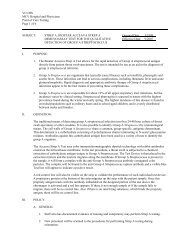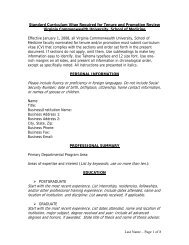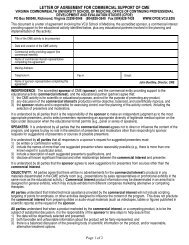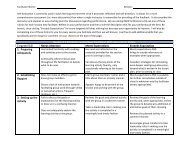submitting image filesToday, most images are obtained digitally and programs such as Adobe Photoshop make it very simpleto modify them. But sometimes by adjusting an image you can make inappropriate changes to yourdata, which could be classified as scientific misconduct. Since 2002, The Journal <strong>of</strong> Cell Biology hasbeen doing simple, routine checks <strong>of</strong> every image <strong>of</strong> all accepted manuscripts to look for signs <strong>of</strong>manipulation. In some cases, this step has caused editors to withdraw the acceptance <strong>of</strong> a paper, andin a few cases, to notify relevant institutions. Other prominent journals, including Science and Nature,may take similar steps.Here is what The Journal <strong>of</strong> Cell Biology says constitutes inappropriate manipulation <strong>of</strong> images:“No specific feature within an image may be enhanced, obscured, moved, removed, or introduced.The grouping <strong>of</strong> images from different parts <strong>of</strong> the same gel, or from different gels, fields, or exposuresmust be made explicit by the arrangement <strong>of</strong> the figure (e.g., using dividing lines) and in the text <strong>of</strong> thefigure legend. Adjustments <strong>of</strong> brightness, contrast, or color balance are acceptable if they are applied tothe whole image and as long as they do not obscure or eliminate any information present in the original.Nonlinear adjustments (e.g., changes to gamma settings) must be disclosed in the figure legend.”For more information, see Rossner, M., and Yamada K. M. “What is in a Picture? The Temptation <strong>of</strong>Image Manipulation.” J. Cell Biol. 166(1):11–15, 2004.Many times you will be clearly and absolutelyturned down. In other cases, the editors will saythat the work is potentially interesting but toopreliminary, or that it has significant flaws thatpreclude its publication. But other times—quite<strong>of</strong>ten—you will see that the editor is giving youa short to-do list <strong>of</strong> experiments based on thereviewers’ comments, and that the journal will beglad to consider the revised paper. And still othertimes—not frequently, but also not rarely—youwill see that the editor will accept the paper if youonly respond to a few quibbles over language.Sometimes the editors will indicate that they wouldlike to publish your work, provided you make a fewminor revisions or do a few additional experiments.Another possibility is that the reviewers will advisethe editors not to publish the work even if it isrevised, because it is either not sufficiently novelor it does not fit the scope <strong>of</strong> the journal. Mosteditors are happy to talk to you by telephone tohelp you assess whether you should revise andresubmit your paper or try another journal. Inany event, it is important to remain unemotionalduring such conversations.Responding to Reviews. Do not react defensively.Focus instead on the substance <strong>of</strong> eacheditorial comment. Value good advice whereveryou find it. Read the reviews carefully, and communicateyour responses in writing to the editor. Itis a good idea not to respond as soon as you hearfrom the editor. Let a couple <strong>of</strong> days go by. A hastilywritten and emotional response will hurt yourchances for resubmission. Do not be sarcastic anddo not speculate on who the reviewer might be orwhy he or she might be trying to thwart your work.If the reviews include a request for additionalinformation that will require a few more experiments,carry them out and send your responseto the editor. You can make the process easier byrepeating each comment, stating your response,and indicating explicitly where in your paper youare making a recommended change.130 excellence everywhere
If you think a requested additional experiment isunreasonable, write a rebuttal letter explainingwhy the experiment cannot be done or why itwill not help strengthen the conclusions <strong>of</strong> yourpaper. You may discuss your concerns with theeditor before working on a revised manuscript.For example, you should ask, “If I do revisionsA and B, but instead <strong>of</strong> doing experiment C, I doa different but related experiment, D, will youstill consider a revised manuscript?” Rememberthat you are the person best acquainted with thedetails <strong>of</strong> your work and the limitations <strong>of</strong> yourresearch tools. If you think a referee’s commentsare completely <strong>of</strong>f the mark, write a rebuttal letterexplaining your concerns. If all three referees, oreven two out <strong>of</strong> three, had serious misgivings,it may be difficult to convince the editor that thereferees missed the point.If the main problem is that the manuscript doesnot convey the importance <strong>of</strong> the work, you maywant to rewrite it and add more data. You mightwant to check with the editor first to make surethis is an appropriate course <strong>of</strong> action.Regardless <strong>of</strong> how you proceed, keep youremotions in check. You should never demean thereviewers. The reality is that reviewers, especiallythose who manage their own laboratories,sometimes work under unrealistic time pressures.Occasionally, the reviewer selected may nothave the expertise to judge a paper competently.Whatever the case, do not question a reviewer’sexpertise. If you think a reviewer missed animportant point, politely tell your editor, who hasthe option <strong>of</strong> identifying additional reviewers foryour paper if doing so seems warranted.In the end, you will have to do a cost-benefitanalysis. If you believe that satisfying all thereviewers’ concerns would bog down yourresearch program in unnecessary experiments,you may have no choice but to take your paperelsewhere.if you are asked to review a paperAs your relationships with journal editors develop, you may be asked to review manuscripts submittedby other scientists. Take the task seriously. Do the reviews thoroughly and promptly. If you do not havetime or do not think you have the right expertise, let the editors know right away. If a paper arrives andupon reading it you see it is beyond your expertise, again, let the editor know quickly. They will not holdthis against you. A late or weak review, however, could hurt your reputation with the editors.Once you have accepted a paper to be reviewed, do your work on it quickly so as not to delay thereview process. This is good not only for moving the science forward but also for building a good relationshipwith the journal. Be a discerning reviewer, but review others as you would like to be reviewedyourself. Be polite, not demeaning. Be specific about the paper’s shortcomings, and be frank about howthe author might remedy them. Not every paper merits publication, but do not frame your comments soharshly that the investigator will see no way forward with his or her work.You will be asked not to reveal the contents <strong>of</strong> any article reviewed and will be reminded that youshould not use your knowledge <strong>of</strong> the pre-published results to further your own research. Take this admonitionseriously—it is essential that you respect the confidentiality <strong>of</strong> the review process. If you havea conflict <strong>of</strong> interest that precludes you from reviewing an article (e.g., you are directly competing withthe author <strong>of</strong> the article you are reviewing or the author is one <strong>of</strong> your former trainees), stop reading thepaper and let the editors know immediately. They will not be pleased if they find out about a conflict <strong>of</strong>interest after you have reviewed the paper.The benefits <strong>of</strong> serving as a reviewer are potentially great. Not only will you learn about others’ research,you will improve your own critical skills and confirm your standing as a knowledgeable scientist in theeyes <strong>of</strong> the editors. Your own future papers will be taken more seriously if you do good reviews.increasing your impact: getting published131
- Page 3 and 4:
A R e s o u r c e f o r S c i e n t
- Page 5 and 6:
Table of ContentsVII119PrefaceChapt
- Page 7:
135 Chapter 10E x p a n d i n g Y o
- Page 15 and 16:
Q u e s t i o nq&aWhat Is a “Tenu
- Page 17:
preparing for immediate submission,
- Page 22 and 23:
Practicing the Talkn Practice your
- Page 24 and 25:
your one-on-one interviews you have
- Page 26 and 27:
If talking directly about money is
- Page 28 and 29:
When the institution responds and y
- Page 30 and 31:
equipment and supplies. Maintenance
- Page 32 and 33:
Q u e s t i o nq&aIs your instituti
- Page 34 and 35:
Working With Human SubjectsWhether
- Page 36 and 37:
RESPONSIBILITIES BEYONDTHE LABORATO
- Page 38 and 39:
UNDERSTANDING YOURINSTITUTION AND H
- Page 40:
Criteria for PromotionStructure of
- Page 45 and 46:
Q u e s t i o nWhat’s in a Name?q
- Page 47 and 48:
Screening ApplicantsWhen you review
- Page 50 and 51:
Interpersonal Skillsn How important
- Page 52 and 53:
Multinational Organizations are hir
- Page 54 and 55:
n If there is an office that handle
- Page 57 and 58:
n Seek funding and publish papers (
- Page 59 and 60:
In fact, even though you yourself h
- Page 61 and 62:
n Craft a statement that you feel c
- Page 63 and 64:
n When you delegate authority to so
- Page 65 and 66:
n Use only pens, preferably with wa
- Page 67 and 68:
Strategy sessionsShould you decide
- Page 69 and 70:
Finding Good Papers for Journal Clu
- Page 71 and 72:
If possible, invite people in your
- Page 73 and 74:
Q u e s t i o nq&aHow do I avoid po
- Page 75 and 76:
The International Committee of Medi
- Page 77 and 78:
Managing Conflictin the LabConflict
- Page 79 and 80:
steps for dealing with conflictWhen
- Page 81 and 82:
chapter 5managing your time“ Succ
- Page 83 and 84:
Check your work: the 90-year though
- Page 85 and 86:
n Make and keep appointments with y
- Page 87 and 88:
n Help them seek advice without tak
- Page 89 and 90: FAMILY MATTERSMany scientists face
- Page 91 and 92: chapter 6project management“ We m
- Page 93 and 94: My project is to get a grant funded
- Page 95: ObjectivesObjectives are the end re
- Page 98 and 99: The key events schedule and the act
- Page 100 and 101: Microsoft Project, a program that s
- Page 102 and 103: Martin, Vivien. Managing Projects i
- Page 104 and 105: appendix II: Example of a Work Brea
- Page 106 and 107: appendix iv: Example of a Gantt Cha
- Page 108 and 109: e h i n d c l o s e d d o o r s :w
- Page 110 and 111: Who might be interested in supporti
- Page 112 and 113: Call your program officerProgram of
- Page 114 and 115: direct costs vs. indirect costsDire
- Page 116 and 117: RESOURCESAllen, Ernest M. “Why ar
- Page 118 and 119: the next generation of students (th
- Page 120 and 121: Seek Feedback through a Formal Peer
- Page 122 and 123: Encouraging Student Questionsn Do n
- Page 124 and 125: Here are some ways you can help the
- Page 126 and 127: n Are there curriculum changes unde
- Page 128 and 129: a relaxed format for talking about
- Page 130 and 131: spend in preparing an effective cou
- Page 132 and 133: The Publishing ProcessTypes of Jour
- Page 134 and 135: A word about impact factorsThe impa
- Page 136 and 137: C r e a t i n g a n i n t e g r a t
- Page 138 and 139: may need to take the first author p
- Page 142 and 143: Submitting your Paper to Another Jo
- Page 144 and 145: RESOURCESDavis, Martha. Scientific
- Page 146 and 147: increase your impact as a scientist
- Page 148 and 149: Q u e s t i o nq&aHow do I communic
- Page 150 and 151: n Offer criticism and correction in
- Page 152 and 153: It is important to discuss career g
- Page 154 and 155: When Mentoring,Advisory, or Supervi
- Page 156 and 157: For researchers in developing count
- Page 158 and 159: n Is travel safe and convenient, or
- Page 160 and 161: n The expected contribution of each
- Page 162 and 163: Meetings. Set up systems to ensure
- Page 164 and 165: SPECIAL CHALLENGESFOR THE BEGINNING
- Page 166 and 167: e an important connection to future
- Page 168 and 169: The invention of a new method or pr
- Page 170 and 171: licensee, who can charge others for
- Page 172 and 173: Most profound for developing countr
- Page 174 and 175: Finally, the patents have been chal
- Page 176 and 177: And, India benefited as a supplier
- Page 178 and 179: paperwork involved in purchasing1.
- Page 180 and 181: labeling mattersA case in point: In
- Page 182 and 183: equipment, freeze-drying equipment,
- Page 184 and 185: Responsibilityfor materialsIf an or
- Page 186 and 187: Recent Improvementsin Materials Tra
- Page 188 and 189: “Knowledge is power.” —Sir Fr
- Page 190 and 191:
MOUMemorandum of UnderstandingRFPRe
- Page 192 and 193:
notes continued182 excellence every
- Page 194:
notes continued184 excellence every


